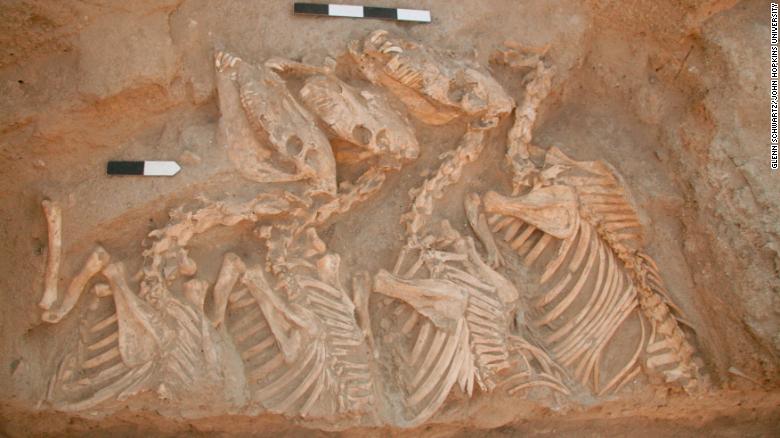They create "sturgeon-paddlefish", an unexpected hybrid 0:53
(CNN) --
Bronze Age bioengineers created the first hybrid animal: a majestic horse-like creature known as a kunga that had a donkey mother, a Syrian wild ass for a father and lived 4,500 years ago, according to new research. based on DNA sequencing of the animal skeleton.
Descriptions and images in Mesopotamian art and texts portray a mighty animal that pulled war chariots into battle and royal vehicles on parade.
However, his true identity had long puzzled and divided archaeologists.
Domesticated horses did not arrive in the region, sometimes called the Fertile Crescent, until 4,000 years ago.
The intact skeletons of the creatures were buried alongside people of high status, the upper layer of Bronze Age society, at the Umm el-Marra burial complex in northern Syria, suggesting that the animals occupied a very special position.
Analysis of the kunga's teeth showed that they had bites in their mouths and were well fed.
However, the bones of horses, donkeys, donkeys, mules, and other equids are very similar and difficult to differentiate, making it impossible to definitively identify the animal simply by examining the skeletons.
Now, analysis of DNA extracted from bones buried at Umm el-Marra has revealed that the animal was a cross between a donkey, which was domesticated at the time, and the now-extinct Syrian wild ass, sometimes called a hemippe or onager.
advertising
This makes it the earliest evidence of hybrid animal breeding with parents from two different species, according to research published in the journal Science Advances on Friday.
It was probably created, trained, and then intentionally traded between the elites of the time.
"Since hybrids are often sterile, it means that there was a remarkable level of energy devoted to constantly capturing and breeding wild onagers, raising them with domestic donkeys, and then training these teams of prestigious kungas (which would only last a generation)," he said.
Benjamin Arbuckle, an anthropological archaeologist at the University of North Carolina at Chapel Hill, via email.
He did not participate in the investigation.
"It really shows the innovative and experimental nature of ancient peoples that I think some people only associate with the modern world and also their willingness to invest a lot of resources into the artificial creation of an expensive animal used only by and for the elites."
A panel showing two individuals hunting wild asses dating to between 645 and 635 BC.
C. (British Museum, London).
© Eva-Maria Geigl / IJM / CNRS-Université de Paris
animal of war
Before the advent of the horse, finding an animal willing to charge into battle was a challenge, said Eva-Maria Geigl, head of research at the CNRS (French National Center for Scientific Research) at the University of Paris and an author of the study.
While cattle and donkeys could pull carts, they would not run at an opponent, he said.
"They were not used for warfare, and there were no domestic horses at the time. The Sumerians, who wanted to wage war because they were actually very powerful city-states, had to find another solution."
She believes that the first kunga arose naturally: a Syrian wild ass mated with a donkey.
"They must have seen that the animal was more robust and easier to train. They must have looked at the result of this natural cross and then said okay, we'll do it. For the first time in human history, we'll bioengineer an animal." ".
However, it would not have been easy. The Syrian wild ass was thought to be aggressive and move extremely fast, he said.
Geigl said that an earlier study of mitochondrial DNA, which revealed the female line, had found the kunga to be a hybrid. It was only with nuclear DNA analysis that scientists were able to determine the paternity of the animal.
The Kunga skeletons buried in Umm el-Marra, Syria.
To arrive at their findings, the researchers sequenced and compared the genomes of a 4,500-year-old kunga buried at Umm el-Marra in Syria, an 11,000-year-old Syrian wild ass found at Gobekli Tepe (the oldest known place of worship made by humans in present-day Turkey) and two of the last surviving Syrian wild asses, which became extinct in the early 20th century.
Arbunkle said that most texts referring to the Kungas date from the mid-2000s.
C., and it is unlikely that they were bred before 3000 a.
C., when donkeys appear in the archaeological record.
For the year 2000 a.
By B.C., he said, they had been replaced as draft animals by horses and mules, a cross between a male donkey and a mare.
"This work establishes the idea that hybrids were created by the ancient Mesopotamians, which is great," Arbuckle said.
"But we still don't know how widespread this animal was and it also doesn't address additional questions related to other types of hybrid equids created in the Bronze Age. So there are a lot more questions."












